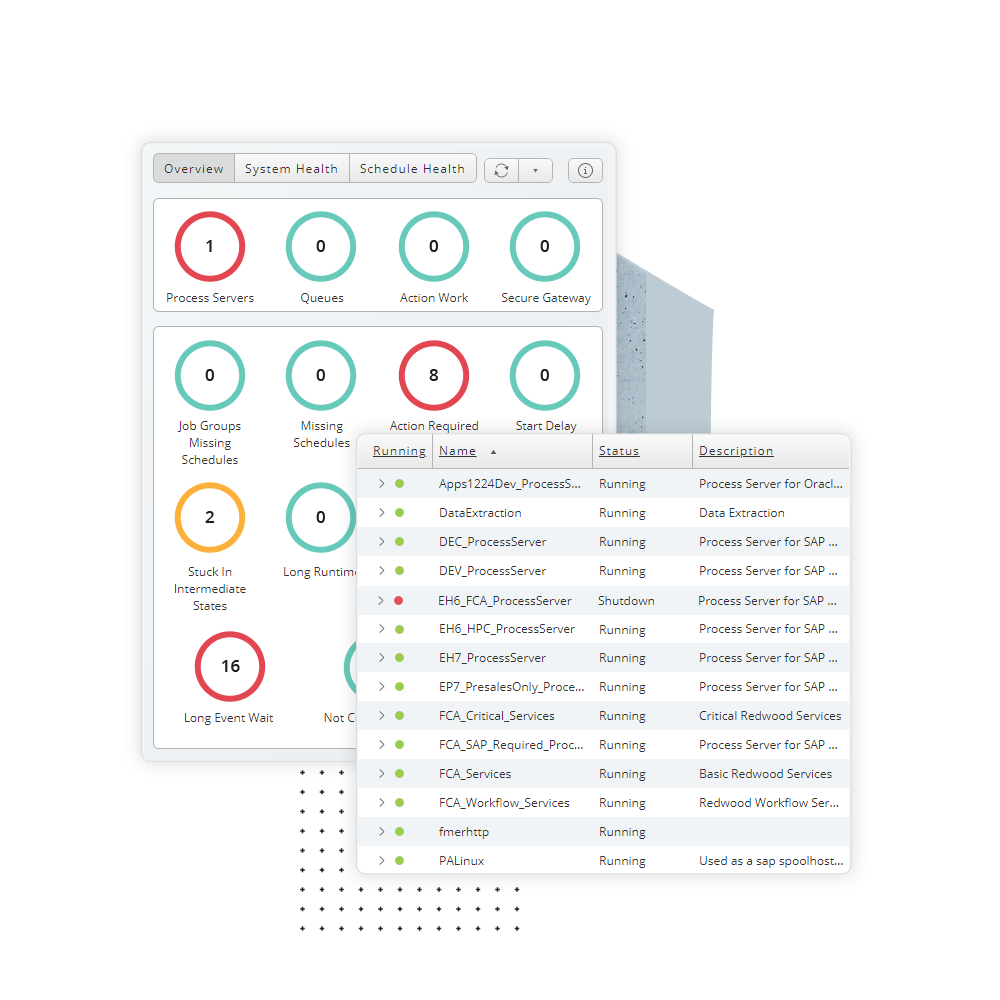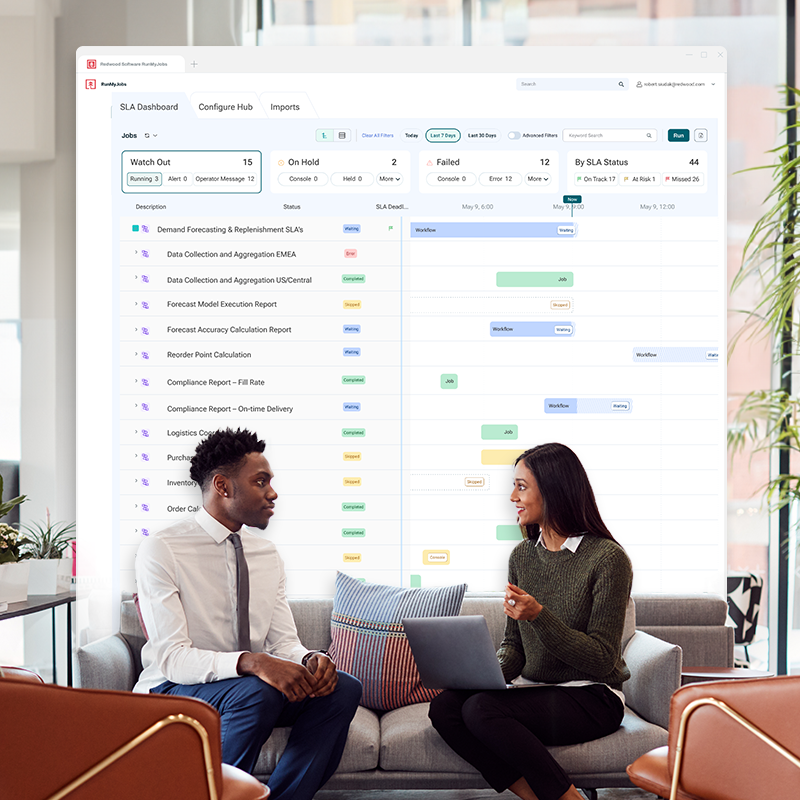Reliable workload monitoring and observability
Build a resilient automation fabric with RunMyJobs by Redwood, a powerful Service Orchestration and Automation Platform.

Hands-off workload automation
Achieve seamless automation with comprehensive design and runtime features.
-
Comprehensive visibility
Monitor your jobs and workflows at any time through centralized dashboards, reports and the RunMyJobs API.
-
Intelligent workflows
Eliminate stalled workflows and manual intervention by building automations that self-recover and escalate to the appropriate teams.
-
Rapid adaptation
Manage workflow schedules according to operational and service-level agreements with predictive SLA monitoring and controls.

Gartner® 2024 Magic Quadrant™ for SOAP
Gartner has named Redwood as a Leader positioned furthest in Completeness of Vision in the newly released Magic Quadrant for Service Orchestration and Automation Platforms (SOAPs).
Click below to get your copy of the 2024 Gartner Magic Quadrant for SOAP report.

Monitor your workflows in real time
Rapidly get to the root cause of a performance issue or outage with reliable tracking and monitoring of your end-to-end automations and supporting systems via focused dashboards.
- Track the health and performance of every automated process.
- Get insights into performance and status from system-wide and individual process views.
- Visually follow individual job and workflow progress in real time.
- Quickly identify issues, drill into affected processes and take action.
- Gain maximum visibility with logging during execution and upon workflow completion.

Assemble an enduring automation fabric
Eliminate uncertainty and wasted effort by configuring automations to run dynamically when the time is right.
- Customize scheduling with downtime windows, critical periods and regional variations.
- Respond to events right away by monitoring for specific conditions.
- Optimize performance and prevent server overload with dynamic workload balancing.
- Eliminate “job-watching” with alerts and integration with collaboration and ITSM tools.
- Optimize workflow success by using the workflow playback feature during design.
- Integrate with your chosen monitoring or observability solution.
RunMyJobs enables your team to set up an integrated framework of automation tools — a central nervous system to drive your mission-critical processes.

Achieve SLAs on time every time
Deliver promised performance of critical business workflows and processes with service-level agreement monitoring.
- Represent real agreements with rules that define time windows and leniency.
- Quickly examine overall scheduling and SLA status from the timeline dashboard.
- Configure triggers for alerts, service management or other automations.
- Quickly access affected workflow configurations to investigate optimizations.
RunMyJobs uses machine learning to monitor processes and forecast process execution time to predict potential SLA breaches against configured SLA rules.

Aggregate and analyze results
Extract actionable insights and key metrics when you use RunMyJobs’ integrated report builder to generate ad-hoc or scheduled reports. Export comprehensive process execution history data to your BI systems for interactive analysis.

Connect RunMyJobs to ServiceNow
- Fetch ServiceNow incident information and create, automate and update in RunMyJobs.
- Create a ServiceNow incident and respond with RunMyJobs’ built-in messaging tool.
- Enable IT teams to take action by executing automations from ServiceNow.
Monitoring and observability FAQs
What's the difference between monitoring and observability?
Monitoring and observability, while related, have distinct roles in IT operations. Monitoring involves tracking specific metrics and known conditions within a system. It relies on predefined alerts to notify teams about high CPU usage, latency or outages. Monitoring tools provide real-time data and are essential for quickly identifying and addressing performance issues.
On the other hand, observability is about understanding a system’s internal states based on its external outputs. It allows IT teams to gain insights into the "unknown unknowns" of complex systems. Observability platforms aggregate telemetry data, such as logs, traces and metrics, to provide a comprehensive view of system health and performance. This approach helps debug, troubleshoot and identify root causes of issues in distributed systems, microservices and cloud-native environments.
Learn about DevOps workflow automation and why continuous monitoring matters.
What are the three main types of monitoring?
The three main types of monitoring are infrastructure monitoring, application performance monitoring (APM) and network monitoring. Infrastructure monitoring involves tracking the health and performance of physical and virtual IT infrastructure components, such as servers, storage and network devices. This helps identify hardware failures, resource bottlenecks and capacity issues within IT systems.
APM focuses on software application performance and availability. APM tools monitor response times, transaction throughput and user experience, providing developers and operations teams with actionable insights. This type of monitoring is crucial for detecting and troubleshooting performance issues in complex, distributed applications, including those deployed in cloud environments and using microservices or serverless architectures.
Network monitoring tracks the performance and availability of network components, including routers, switches and firewalls. It ensures that data flows efficiently across the network and identifies issues such as latency, packet loss and bandwidth utilization. Effective network monitoring is essential for maintaining the performance and reliability of both on-premises and multi-cloud infrastructures, supporting end-to-end IT operations.
Discover how to harness the power of extensibility in end-to-end automation solutions.
What is the proactive monitoring method?
Proactive monitoring involves continuously observing and analyzing system performance to predict and prevent potential issues before they impact end-users. Unlike traditional monitoring, which typically reacts to incidents after they occur, proactive monitoring aims to identify real-time patterns and anomalies. Setting thresholds and leveraging advanced analytics, including AIOps, helps IT teams address issues early.
Proactive monitoring utilizes various tools and techniques, such as data collection instrumentation, metrics visualization and open-source platforms like OpenTelemetry. It often integrates with DevOps team practices, enabling operations teams and SREs to maintain system performance, reduce downtime and enhance the overall reliability of IT systems. This approach is particularly effective in complex environments, including Kubernetes and multi-cloud architectures.
Read Gartner’s predictions for workload automation and the role of scheduling, monitoring, visibility and alerting.
What is important to monitor for workload automation?
For effective workload automation, it’s essential to monitor several key aspects. These include job status, execution times and resource utilization. Monitoring job status helps track the progress and completion of automated tasks, ensuring that any failures or delays are promptly addressed. Execution times provide insights into performance trends, helping identify any bottlenecks or inefficiencies in the automation process.
Resource utilization is also crucial, as it involves monitoring CPU, memory and storage usage to ensure optimal performance and avoid overloading a system. Tracking dependencies between tasks and workflows is also important to prevent cascading failures and maintain the overall reliability of the automation system. By leveraging observability tools and monitoring systems, IT teams can gain comprehensive visibility into their workload automation environments and facilitate efficient and reliable operations.
Envisage the future of workload automation management.
Additional IT workload automation resources
Expand your knowledge with helpful articles and resources about digital transformation, business automation and more.



